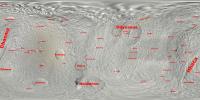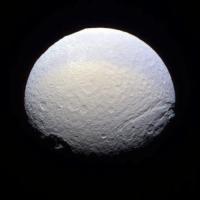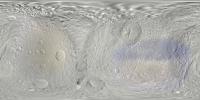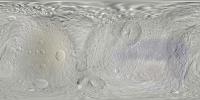Printable Version of Topic
Click here to view this topic in its original format
Unmanned Spaceflight.com _ Cassini's ongoing mission and raw images _ New Names for Tethys
Posted by: volcanopele Apr 28 2008, 06:34 PM
The IAU approved new names for use on Tethys. These names include Scheria Montes (the central massif complex of Odysseus) and Telemus (an ancient impact basin near Ithaca Chasma).
Posted by: elakdawalla Apr 29 2008, 10:55 PM
Thanks again for the map, VP!
--Emily
Posted by: scalbers Apr 29 2008, 11:28 PM
Nice to see the new feature names. Good timing too as I had recently been making some underlying updates.
Posted by: TritonAntares May 2 2008, 09:29 AM
Great. Necessary improvement - I hope the IAU will release some more namings for structures on the other saturnian satellites soon, especially Iapetus... ![]()
Bye.
Posted by: jasedm May 6 2008, 04:02 PM
Great to have some new names from the IAU, but something's been bugging me for a while and I couldn't place it. In the attachment above, craters Arete and Polyphemus are transposed.
It's a small point, but I have several older (post-Voyager) reference books which show Ajax, Polyphemus and Phemius in a roughly north / south line, rather than with Arete between Ajax and Phemius ( see also http://www.spaceref.com/news/viewsr.html?pid=20166)
Can anyone clarify??
Jase
Posted by: jasedm May 11 2008, 09:53 AM
Think my last post must have got lost in the changeover.... see above
![]()
Posted by: Decepticon May 11 2008, 02:04 PM
Some new pics are up http://saturn.jpl.nasa.gov/multimedia/images/raw/casJPGFullS40/N00108954.jpg
Posted by: scalbers May 11 2008, 08:43 PM
Nice view that includes the south pole. Looks like Melanthius on the terminator and Odysseus indenting the limb. Any more on the way - Decepticon?
Posted by: ugordan May 11 2008, 08:52 PM
There's more taken earlier, from closer in but at a higher phase angle : http://saturn.jpl.nasa.gov/multimedia/images/raw/raw-images-details.cfm?feiImageID=152933
Here's the distant sequence IR3/GRN/UV3 and enhanced:
Posted by: scalbers May 11 2008, 09:23 PM
Interesting - kind of a double close approach I see when looking at a Celestia animation. The earlier image Ugordan is showing looks like it has some new details S of Antinous and E of Naubolos (at least compared with my recent mosaic as it appears on VP's map).
Steve
Posted by: Decepticon May 11 2008, 11:34 PM
Scalbers I hope these images help with your mapping!
Posted by: scalbers May 17 2008, 06:26 PM
Yes - here's a new revision with several changes.
The full resolution map is at http://laps.noaa.gov/albers/sos/sos.html#TETHYS
The close image mentioned from this month's flyby is used in the small area S of Antinous and E of Naubolos. The lo-res color image (leading hemisphere) from Ugordan was merged in (using hue and saturation information) with the higher-res intensity details. Looks good with the gold color, and with the color contrast for the equatorial dark band (bellyband lite?). Perhaps some color adjustment would still be helpful to reduce the bluish cast in the band? This is tricky since it is also near the limb where there may be a photometric coloring effect added in. In general one could review the lo-res color imagery from the mission to add in color information over more of the surface - I'd like to consider any hints that you all may have.
A number of images were re-navigated. Hopefully they're closer now even if some further adjustment may be needed.
That's the latest,
Steve
Posted by: ugordan May 17 2008, 06:50 PM
That raw image of mine was further saturated from the original IR3/G/UV3 filter to bring out differences. In reality, there's virtually no color present; consider http://farm1.static.flickr.com/188/385517231_d3bc278d5c_o.png. If anything, the band is grayish-blue, while the region around it very, very subtly orangish. Also, http://farm3.static.flickr.com/2322/2366261391_1d53249afc_o.png for an RGB composite showing the band and an enhancement to reduce low phase blandness.
Overall, your color for the band seems pretty much OK to me, I'd just tone it down significantly.
Posted by: scalbers May 17 2008, 07:01 PM
Thanks for the ideas Gordan. I guess I could reduce the saturation of your image that I used, or use one of the pair of color images you just posted. Overall I did like the coloration of the trailing hemisphere press-release image from CICLOPS I had been using in that area, so I was hoping to get something similar added elsewhere.
I think this is the photojournal release for the CICLOPS image:
http://photojournal.jpl.nasa.gov/catalog/PIA06140
Posted by: scalbers May 21 2008, 07:14 PM
Next version of my Tethys map is now on-line. The color saturation for Gordan's leading hemisphere image was reduced so it seems to look somewhat better. A number of images were renavigated so they should mesh together better and hopefully more accurately located. New images are included from both May 10th and 18th.
Full res is at http://laps.noaa.gov/albers/sos/sos.html#TETHYS
If the leading hemisphere dark band really is bluer than the surroundings, I would wonder if the implied composition could be different than on some of the other satellites with darker material? Iapetus of course comes to mind with dark material on its leading side, though Dione and Rhea seem to be darker on their trailing sides? Tethys as well has the other more general darker region on its trailing side.
Steve
Powered by Invision Power Board (http://www.invisionboard.com)
© Invision Power Services (http://www.invisionpower.com)




